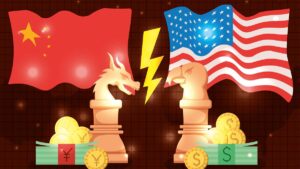Monsters of Rock: Another forecaster takes a dump on nickel

Pic: AntonioSolano/iStock via Getty Images
- Fitch commodity forecaster BMI Commodity Insights has dumped on nickel, cutting its 2024 price forecast by 10% to US$18,000/t
- Sayona Mining decides to keep going, aiming to bring down costs at its North American Lithium operation Canada by growing production
- Miners up slightly as battery and base metals rise
It gets no brighter for nickel, with another forecaster cutting its outlook for 2024 in the face of an Indonesian supply glut.
Fitch unit BMI Commodity Insights slashed its 2024 forecast from US$20,600/t to US$20,000/t at the end of last year only to find prices tumble south of those projections and fast.
As nickel hurtled towards US$16,000/t as much as 40,000t of annualised nickel output was cut by Australian exporters in January – around a quarter of the nation’s output, with further supply cuts flagged in New Caledonia and Colombia from Glencore and South32 (ASX:S32).
The real damage for market sentiment was done by BHP (ASX:BHP), which is investigating placing its 80,000tpa Nickel West division, operating virtually non-stop since 1966 under Western Mining Corporation, on care and maintenance.
Thanks to inflation and capital costs needed to retool the business – made core just a few years ago after years on the chopping block as its customer base shifted from stainless steel to the ESG friendly EV battery sector – its breakeven is now around US$20,000/t. The business lost US$200m in the December half and fuelled a profit-snatching US$2.5b impairment.
BMI has now chopped its forecast for the battery metal from US$20,000/t to US$18,000/t for 2024. Prices briefly rose above that level amid a slowdown in mine approvals in Indonesia and surprisingly high stainless steel production in China which prompted Macquarie to say it could wind up in a surprise deficit this year.
But Fitch sees a hefty surplus still, with China’s subdued economy and the digestion by the market of announced production cuts sending spot prices back to US$17,339/t.
“We expect the nickel market to remain in surplus in 2024, with the balance hovering around 263kt, amid a significant rise in supply from leading producer Indonesia while a subdued global economic outlook presents downside risks to demand,” he said.
“Beyond that, we now see the market remaining in surplus throughout our forecast period, despite booming demand for nickel from the electric vehicle (EV) battery industry driving up nickel consumption, as Indonesia’s production growth continues to surge.
“Indonesian supply has saturated the global market and led to a significant increase in global nickel supply, with production expected to jump from 2.4Mt in 2019 to 4.3Mt in 2024.”
Indonesian growth impressive
BMI thinks Indonesia will keep that supremacy long-term.
“Indonesia is now emerged as the leading producer of refined nickel globally thanks to domestic and foreign firms rapidly expanding the country’s nickel refining capacity,” its analysts said.
“We anticipate that Indonesia will sustain its position as the leading refined nickel producer over the forecast period 2024-2033, with production projected to increase from 1.7Mt in 2024 to 3.8Mt in 2033.”
By 2033, Fitch says Indonesia and China will account for 68% of global nickel output, but flagged that rising environmental focus around Indonickel operators could limit growth.
The outlier on the ASX is Nickel Industries (ASX:NIC), which has become one of the world’s largest purveyours of nickel tonnes by partnering in Indonesia with Chinese stainless steel giant and processing innovator Tsingshan.
This week it announced plans to double its share in the Excelsior HPAL project in Indonesia. It will eventually own 55% of the site, the first battery-grade nickel plant Nickel Industries will operate.
It has previously converted nickel pig iron to nickel matte to access the electric vehicle market.
Sayona vows to keep on trucking
Like the cat on the poster Sayona Mining (ASX:SYA) continues to hang in there, saying an operational review supports its case to continue ramping up its North American Lithium mine in Quebec to full scale.
Owned 75% by Sayona (25% Piedmont Lithium (ASX:PLL)), the operator intends to reduce unit costs by the end of 2024.
It announced the operational review at the end of January, making 14 staff redundant in Quebec.
Unit operating costs in the December quarter came in at $1397/dmt, around $450/dmt higher than average selling prices as its cash balance fell by 32% to $158m.
But that’s not enough to prompt a mothball decision.
Canada’s big chill led to more downtime than expected, with the NAL mill out of action for 27% of the March quarter, but Sayona said recoveries were improving, hitting 62% YTD.
It produced 24,740t of ~5.45% Li2O spodumene concentrate through the first two months of the year.
Sayona said costs of $1286/dmt (US$839/dmt) seen in the December half were expected to remain stable, with production increases key to bring them down.
“Throughout this process, a key consideration was the direct impact on our dedicated workforce and host communities. This review has also validated our approach to continue to assess capital improvement initiatives that will increase production or lower unit operating costs,” interim CEO James Brown said.
“Looking forward, we will regularly evaluate NAL operations in the ordinary course of business based on prevailing market conditions and the ability to achieve our operating cost targets.
“We are confident that this approach to considering alternatives and maintaining optionality will enable Sayona to maximise value for shareholders ahead of an anticipated recovery in the lithium market.”
Down 40% YTD, Sayona was up over 10.5% by 3pm AEDT today.
Sayona Mining (ASX:SYA) share price today
The broader materials market was up 0.2% despite a rough day for iron ore producers, with bullish moves in battery and base metals sending producers like South32 (ASX:S32), Lynas (ASX:LYC) and IGO (ASX:IGO) higher.
Monstars share price today
UNLOCK INSIGHTS
Discover the untold stories of emerging ASX stocks.
Daily news and expert analysis, it's free to subscribe.
By proceeding, you confirm you understand that we handle personal information in accordance with our Privacy Policy.








